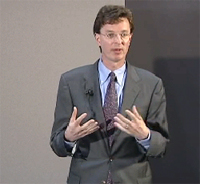April 24, 2008 –- Last January, the Library’s National Digital Information Infrastructure and Preservation Program made awards to four projects that are working with a total of 23 states to collect and preserve state and local digital content at risk of loss. The project has attracted the attention of major organizations that support state activities, such as the National Conference of State Legislatures (external link).
NCSL representatives visited the Library as part of a wide-ranging group of state legislators and legislative IT specialists who helped kick off the digital preservation project being led by the Minnesota Historical Society (external link) to preserve state legislative information.

Robert Horton, director of Library, Publication and Collections at the Minnesota Historical Society.
The event, hosted by NDIIPP with the Historical Society, was held in conjunction with the National Conference’s annual meeting. NCSL is a bipartisan organization that serves the legislators and staffs of the states and territories. In addition to Library, NCSL and MHS representatives, the meeting attendees included legislators and staff from 12 states.
MHS is leading one of four multistate demonstration projects being supported by NDIIPP that are collecting and preserving digital content of interest to Congress, including geospatial information, state legislative records and state executive agency documentation. MHS is specifically targeting state legislative information, and NCSL is an important partner on the project, helping to promote the project findings to state legislators and staff.
Robert Horton, director of Library, Publication and Collections at MHS and the principle investigator on the MHS project, noted that the project’s "primary goal is to capture, preserve and provide access to at-risk content from state legislatures."
The project is working with legislatures in California, Kansas, Tennessee, Mississippi, Illinois and Vermont, to explore improved and enhanced access to legislative digital records. This will involve implementing a trustworthy information management system and testing the capacity of different states to adopt the system for their own use. Content will include bills, committee reports, floor proceedings and other legislative materials.
Horton noted "that use value is going to drive the functions" of the information system, and a number of participants echoed the idea that improved access to the legislative materials would lead to increased use, which would help support the case for preservation.
